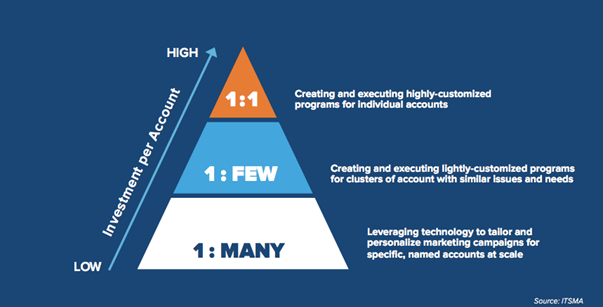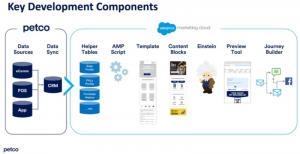Contributors Jessica Fewless and Rob Leavitt outline three common approaches to Account-Based Marketing and discuss the advantages of moving to a personalized, blended strategy.

Note: This piece was co-authored with Rob Leavitt, senior vice president at ITSMA.
In the past few years, Account-Based Marketing (ABM) has grown as a category and really transformed the B2B marketing landscape. But its quick ascent to B2B stardom has left quite a few marketers confused about how best to incorporate it into their organizations.
In particular, marketers are struggling to understand exactly how to build out their ABM programs. Should they target a small handful of accounts or broaden their reach? What types of companies should they focus on? Enterprise? Mid-market? What about existing customers?
While there’s no universal, one-size-fits-all answer to these questions (a lot of it really depends on your organization, business goals and team), there are some guidelines B2B marketers can follow as they build out their strategies. In this article, we’ll flesh out three of the most common ones and lay the groundwork for the next wave of ABM: a personalized, blended ABM strategy that drives results for your organization.
Three approaches to ABM
ABM finds its roots in the early 1990s, when Don Peppers and Martha Rogers published their oft-cited book, “The One-to-One Future,” and made the case for personalized, incredibly relevant customer experiences.
While the book focused mostly on consumer marketing, some B2B marketers took the message to heart. In 2003, ITSMA officially coined the phrase “Account-Based Marketing” and began to work with a handful of top technology companies to codify the approach to target their most strategic accounts.
Since its humble beginnings, ABM has grown into a full-fledged strategy, one that includes three approaches:

One-to-One
With the One-to-One approach, marketers work in full partnership with the account team to create highly customized marketing programs for “markets of one.” This approach includes deep-dive research into individual accounts, long-term programs to build relationships and develop custom solutions and a labor-intensive mix of personalized online and offline programs and activities.
It’s the most popular ABM approach, according to research from ITSMA and the ABM Leadership Alliance, and often focused on a company’s largest potential, existing customers
One-to-Few
The One-to-Few approach takes the research-based principles of One-to-One and applies them to larger groups of accounts. It typically brings together clusters of five to 15 accounts with similar business issues, often in the same industry.
While a One-to-One program might focus on McDonald’s, a One-to-Few program might focus on the top 10 fast food restaurant chains. The coverage is broader but not quite as deep.
A dedicated marketer can support one or several types of clusters, often lightly customized content, events and briefings that leverage other ongoing marketing programs. The program focus is typically split between new prospects and existing accounts.
One-to-Many
The One-to-Many approach emphasizes personalization at scale and typically addresses a strategically curated target list of several hundred or more named accounts. Technology often plays an important role because it helps companies scale the program.
In most cases, reach and investment per account is lower than with other types of ABM but coverage is much broader, so the overall business impact can be just as great. One-to-Many ABM programs are often oriented mostly to new account acquisition.
Making the move to a personalized, blended strategy
A blended approach enables B2B marketers to drive account-based impact with greater speed, efficiency and flexibility across the marketplace. Each approach has its own time and place in an overall marketing strategy, and a more sophisticated combination will increase the breadth and depth of your marketing program.
This will enable you to improve sales and marketing alignment, enhance demand generation efforts, or even target new markets. If you’re using only one, then you’re missing out on opportunities to further increase marketing’s impact on the company’s bottom line.
Instead, the idea is to build upon the approach you’re already using. For example, if you’re already using One-to-One, your first objective is likely to scale and bring ABM to more accounts. Alternatively, if you’re using One-to-Many, a blended ABM approach can help you drive greater impact with some of your most important accounts.
A considerable amount of effort goes into getting a blended approach off the ground, and we’ll cover the steps necessary to see success in a future post. Stay tuned!
Opinions expressed in this article are those of the guest author and not necessarily Marketing Land. Staff authors are listed here.
Marketing Land – Internet Marketing News, Strategies & Tips
(60)
Report Post







